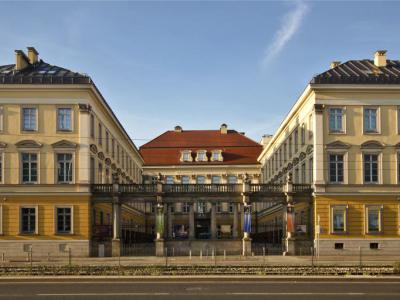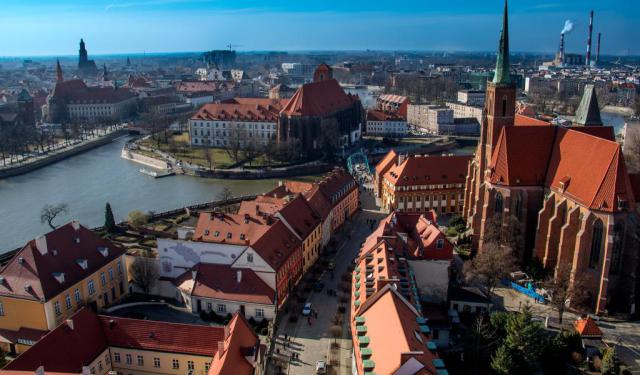
Palac Krolewski (Royal Palace), Wroclaw
The Royal Palace is an architectural treasure nestled in the heart of Wrocław. Originally built as a palace for the Prussian monarchy, this historic edifice has since been transformed into the City Museum, providing a captivating window into the city's rich heritage.
The palace's history is an enchanting journey through different architectural styles and epochs. Its inception can be traced back to 1717 when it was designed in a Viennese Baroque style by Heinrich Gottfried von Spätgen, the chancellor of Bishop Francis Louis of Neuburg. Initially, it served as the residence of Bishop Francis Louis.
However, in 1750, following Prussia's acquisition of Silesia during the First Silesian War, the palace underwent a transformation. It was acquired by Prussian king, Frederick the Great, who made it his royal residence. Under his reign, from 1751 to 1753, the palace was expanded and given a distinct Baroque style, complete with Rococo interiors masterfully crafted by the royal architect Johann Boumann. Boumann's contributions included the addition of a transverse wing housing a magnificent festive hall, a splendid throne hall, and the private quarters of Frederick the Great himself.
After the passing of Frederick the Great in 1786, his nephew, Frederick William II of Prussia, took the reins. Under his rule, the palace underwent another significant transformation. Renowned architect Karl Gotthard Langhans was enlisted to remodel the palace in the classical style. This remodeling project took place between 1795 and 1796, further enhancing the palace's architectural grandeur.
During the mid-19th century, the palace underwent yet another architectural evolution. Architect Friedrich August Stüler introduced elements of the Florentine Renaissance style to the palace's design. This phase of development saw the construction of a new southern wing (1844–1846) and the addition of new courtyard wings, complete with a gate and railing (1858).
In 1918, the palace was generously donated to the city of Breslau (now Wrocław). On September 20, 1926, the Palace Museum was inaugurated within its walls. The museum showcased an impressive array of exhibits dedicated to Frederick the Great, featuring painstaking reconstructions of original palace interiors, as well as a remarkable collection of Silesian art.
The palace's history is an enchanting journey through different architectural styles and epochs. Its inception can be traced back to 1717 when it was designed in a Viennese Baroque style by Heinrich Gottfried von Spätgen, the chancellor of Bishop Francis Louis of Neuburg. Initially, it served as the residence of Bishop Francis Louis.
However, in 1750, following Prussia's acquisition of Silesia during the First Silesian War, the palace underwent a transformation. It was acquired by Prussian king, Frederick the Great, who made it his royal residence. Under his reign, from 1751 to 1753, the palace was expanded and given a distinct Baroque style, complete with Rococo interiors masterfully crafted by the royal architect Johann Boumann. Boumann's contributions included the addition of a transverse wing housing a magnificent festive hall, a splendid throne hall, and the private quarters of Frederick the Great himself.
After the passing of Frederick the Great in 1786, his nephew, Frederick William II of Prussia, took the reins. Under his rule, the palace underwent another significant transformation. Renowned architect Karl Gotthard Langhans was enlisted to remodel the palace in the classical style. This remodeling project took place between 1795 and 1796, further enhancing the palace's architectural grandeur.
During the mid-19th century, the palace underwent yet another architectural evolution. Architect Friedrich August Stüler introduced elements of the Florentine Renaissance style to the palace's design. This phase of development saw the construction of a new southern wing (1844–1846) and the addition of new courtyard wings, complete with a gate and railing (1858).
In 1918, the palace was generously donated to the city of Breslau (now Wrocław). On September 20, 1926, the Palace Museum was inaugurated within its walls. The museum showcased an impressive array of exhibits dedicated to Frederick the Great, featuring painstaking reconstructions of original palace interiors, as well as a remarkable collection of Silesian art.
Want to visit this sight? Check out these Self-Guided Walking Tours in Wroclaw. Alternatively, you can download the mobile app "GPSmyCity: Walks in 1K+ Cities" from Apple App Store or Google Play Store. The app turns your mobile device to a personal tour guide and it works offline, so no data plan is needed when traveling abroad.
Palac Krolewski (Royal Palace) on Map
Sight Name: Palac Krolewski (Royal Palace)
Sight Location: Wroclaw, Poland (See walking tours in Wroclaw)
Sight Type: Attraction/Landmark
Guide(s) Containing This Sight:
Sight Location: Wroclaw, Poland (See walking tours in Wroclaw)
Sight Type: Attraction/Landmark
Guide(s) Containing This Sight:
Walking Tours in Wroclaw, Poland
Create Your Own Walk in Wroclaw
Creating your own self-guided walk in Wroclaw is easy and fun. Choose the city attractions that you want to see and a walk route map will be created just for you. You can even set your hotel as the start point of the walk.
Wroclaw Introduction Walking Tour
Wroclaw, the capital of Poland’s Lower Silesia province, is a travel gem for wandering hearts. Steeped in over 1,000 years of history and a vibrant blend of Polish, German, and other cultural influences, it could easily compete for the title of the most beautiful city in Europe.
The area around Wroclaw was inhabited as early as the 9th century by Slavic tribes. The town was originally part of... view more
Tour Duration: 2 Hour(s)
Travel Distance: 3.7 Km or 2.3 Miles
The area around Wroclaw was inhabited as early as the 9th century by Slavic tribes. The town was originally part of... view more
Tour Duration: 2 Hour(s)
Travel Distance: 3.7 Km or 2.3 Miles
Cathedral Island Walking Tour
Cathedral Island, known as "Ostrów Tumski" in Polish, is a historic and enchanting district in the heart of Wroclaw. This picturesque island, nestled amid the Oder River, is a treasure trove of architectural and cultural wonders that date back centuries.
Begin your journey by crossing the iconic Tumski Bridge. It's not just a pathway but a symbol of love, as couples often attach... view more
Tour Duration: 1 Hour(s)
Travel Distance: 0.7 Km or 0.4 Miles
Begin your journey by crossing the iconic Tumski Bridge. It's not just a pathway but a symbol of love, as couples often attach... view more
Tour Duration: 1 Hour(s)
Travel Distance: 0.7 Km or 0.4 Miles


